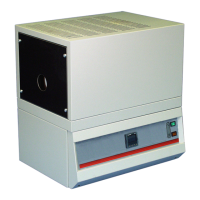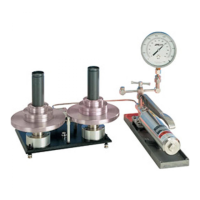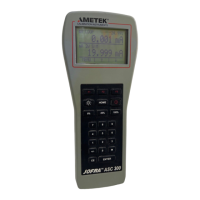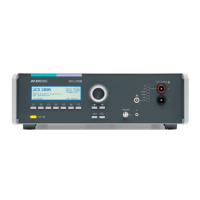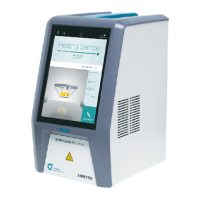14 LS User Manual
4.3 GENERAL PRECAUTIONS
The following points should be considered:
1. When installing the upper grip (particularly heavy ones) on the load cell eye end, avoid bumping
the eye end. If the grip is a close t, DO NOT FORCE IT, establish the reason and rectify. Im-
mediately set, or re-set, the bottom limit stop so the grips will not meet when the crosshead is
lowered. See section 7.5 LIMIT STOPS.
2. In both tension and compression tests, centre the specimen in line with the axis of the load cell
and the bottom xed anchoring device or pin to avoid side thrust.
3. In compression tests, care must be taken to avoid bringing the platens together or against solid
specimens at high speed. Load cells thus damaged cannot be repaired. Ensure that the lower
crosshead limit is set correctly. See section 7.5 LIMIT STOPS.
4. In compression tests, if special lower xtures are used, ensure that they are xed in position
so they cannot be accidentally moved to block the normal downward movement of the upper
xture, e.g. where a tongue on the upper xture must t into a slot in the lower xture. See sec-
tion 7.4 LOWER ANCHOR PIN ADJUSTMENT.
5. Avoid overloading beyond the load cell rated capacity. Prior to testing ensure, if possible, that
the maximum force anticipated will not exceed the capacity of the cell installed. If maximum
capacity is approached during a test, run the machine at slow speed in local mode, and reverse
the crosshead if capacity is exceeded.
6. LLOYD INSTRUMENTS load cells are built to exceed the standards as set out by ASTM, BS,
DIN etc. All load cells on LS machines are user-changeable. Various capacities are available
from 5N up to the capacity of the frame. While cells may be used below 10% of capacity it is
recommended that, when such lower forces are anticipated, a lower force cell be installed such
that the test force will fall in the upper 90% of its range. This will give the best signal to noise
performance of the load measuring system.
NOTE: All machines incorporate overload protection, which will stop the machine if
capacity is exceeded in either tension or compression. However, at higher speeds, mo-
mentum may carry the crosshead far enough after shut-off to damage the cell. All load
cells can be damaged this way but in low force cells this distance is very short. Load cells
that incur damage due to overloading cannot be repaired.
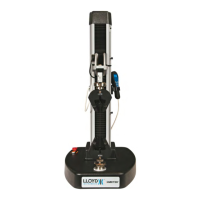
